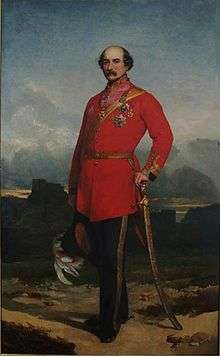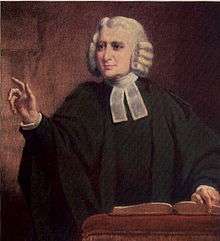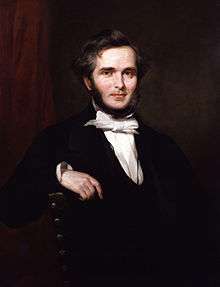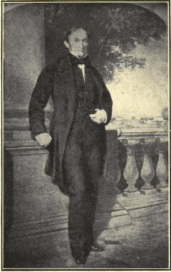William Gush
William Gush (23 April 1813 - 28 February 1888) was an English portrait painter born near London.

The Dictionary of Victorian Painters describes Gush’s style of painting as being in the keepsake tradition and that his female types are very similar to those of Charles Baxter.[1] Kingsmead’s A Dictionary of Artists 1760-1893 lists him as having exhibited 53 pictures at the Royal Academy, 4 at the British Institution and 2 at the Suffolk Street Galleries.[2] He has numerous pieces in the National Portrait Gallery in London. There 354 known portraits painted by him.[3]
Royal Academy
In 1833 Gush’s first painting was accepted to be hung in the Royal Academy Exhibition staged at the National Gallery. The subject of this portrait was Sir John Harrison Yallop, late mayor of Norwich. The same year he was awarded the Gold Isis Medal by the Society for the Encouragement of Arts, Manufacturing and Commerce. In 1837, Gush had another portrait hung in the Royal Academy exhibition of the Duke of Beaufort, in the uniform of the Gloucester Yeomanry Cavalry.
Some of the eminent subjects commissioning William were Lieutenant Colonel Townsend of the 14th Royal Light Dragoons, whose portrait was exhibited in 1840 at the Royal Academy Exhibition, the Right Reverend James Henry Monk - Lord Bishop of Gloucester and Bristol, painted for the Bishop’s College in Clifton exhibited in 1842, and the Earl of Bantry exhibited in 1844. In 1853, Gush’s exhibit at the Royal Academy exhibition was a portrait entitled "Mrs Mills". His last portrait to be exhibited at the Academy was in 1865 and depicted Mrs Philip Vanderbyl; his subsequent entries in 1867 and between 1872-4 had less specific titles such as "At Lessons and Blackberries". The Royal Academy moved from sharing the National Gallery’s premises in Trafalgar Square to the rebuilt Burlington House in 1869 and the artist’s final painting entitled "The New Song" (1874) brought to an end over forty years of exhibiting.[3]
Wesleyan Methodist Magazine

In 1844 and 1845 William Gush contributed all the portraits of Methodist ministers, published in the Wesleyan Methodist Magazine. By 1847 William bought a studio at the prestigious address No 17 Stratford Place, an exclusive cul-de-sac situated off Oxford Street, London.
His commitments back in England still kept him very busy, the main one of these being the provision of portraits for the Wesleyan Methodist Magazine. He also painted other portraits including one depicting John Curwen, a composer, now held at the National Portrait Gallery in London.
In 1860 Gush had provided the portraits for all twelve issues of the Methodist Magazine, just three years later the number was halved and the last engraving of a portrait by William Gush (of the Reverend Thomas T N Hull) appeared in February 1864. Photography now superseded portrait painting as a means of illustration, though the well-to-do would still wish to have their portraits painted to adorn the walls of their grand houses.[3]
Nova Scotia and New Brunswick
Shortly after the end of the Crimean War, William Gush visited Nova Scotia for the first time. In 1858 Gush sailed to Halifax, Nova Scotia on board the steamer Niagara, leaving Liverpool on 14 August. He stayed in the region for about four months.[5] During this time he painted several portraits of notable figures in the region.
.jpg)
Gush was commissioned to paint the portrait of a key figure from the Crimean War, Lieutenant General Sir William Fenwick Williams of Kars, Bart., KCB. Williams, born in Nova Scotia at the turn of the 19th century, is remembered for his gallant defense of the town of Kars during the conflict. Many honours were subsequently bestowed upon Sir William and between 1865 and 1857, he served as Lieutenant-Governor of Nova Scotia. The portrait was painted for the Parliament House in Halifax, now called Province House.
The Board of Trustees of Mount Allison University at Sackville invited Gush to paint a full size portrait of Charles Frederick Allison, the founder of the University. Whilst in Sackville, William also painted portraits of Charles Allison’s wife and daughter and Reverend Humphrey Pickard, 1st President of the University and Methodist minister.[6] He also did a painting of the Honourable William Botsford, a local magistrate.[7]
He returned to Liverpool on the Europa on 20 December 1858. After his return, in the early 1860s the celebrated Nova Scotian military officer Sir John Inglis, a military gentleman whose career is remembered for his heroic defense of the residency at Lucknow during the Indian Mutiny in 1858, commissioned Gush to paint his portrait. In 1864 William’s portrait of Sir John Inglis (who was by now deceased) was included in the Royal Academy’s Exhibition, after which the painting was transported to Halifax, Nova Scotia from where the commission had originated. It is now hung in Province House. A further portrait of Reverend John Beecham, the first president of the Wesleyan Conference of Eastern British America was completed by Gush on his return to England.
William Gush died on 28 February 1888 at Old Malden, England. His body was buried alongside that of his wife in the graveyard at St John the Baptist Church, Old Malden on 3 March 1888.[3]
Works
- Charles Wesley
- Sir John Harrison Yallop, late mayor of Norwich. (1833)
- Duke of Beaufort, in the uniform of the Gloucester Yeomanry Cavalry
- Frederick Aaron,
- Abraham and Susannah Riddiford.
- Lieutenant Colonel Townsend of the 14th Royal Light Dragoons
- Reverend James Henry Monk Lord Bishop of Gloucester and Bristol, painted for the Bishop’s College in Clifton exhibited in 1842
- the Richard White, 1st Earl of Bantry (1767–1851) exhibited in 1844.
- Mrs Mills.
- Lieutenant General Sir William Fenwick Williams of Kars, Bart., KCB is
- Charles Frederick Allison, the founder of the University.
- Charles Allison’s wife and daughter
- Reverend Humphrey Pickard
- Reverend John Beecham, the first president of the Wesleyan Conference of Eastern British America
- John Curwen, a writer on music.
- Sir John Eardley Inglis
- Mrs Philip Vanderbyl
- At Lessons
- and Blackberries
- The New Song (1874)
References
- Christopher Wood. Dictionary of Victorian Painters, Antique Collectors' Club, 1971, p. ???
- Graves, Algernon. A Dictionary of Artists 1760-1893 (Kingsmead Reprints, 1901), page. ??? The 1969/1970 edition is entitled A dictionary of artists who have exhibited works in the principal London exhibitions from 1760-1893 / compiled by Algernon Graves
- William Gush - Portrait Painter by Mrs Dee Helmore
- See engraving of the portrait at Proceedings of the Wesley Historical Society. December 1957
- Notes held at Mount Allison University indicate that William Gush may have made a subsequent visit to Nova Scotia in the summer of 1859.
- Canadian Biography Online
- Moncton Museum of Art, New Brunswick
External links
- 18 paintings by or after William Gush at the Art UK site

